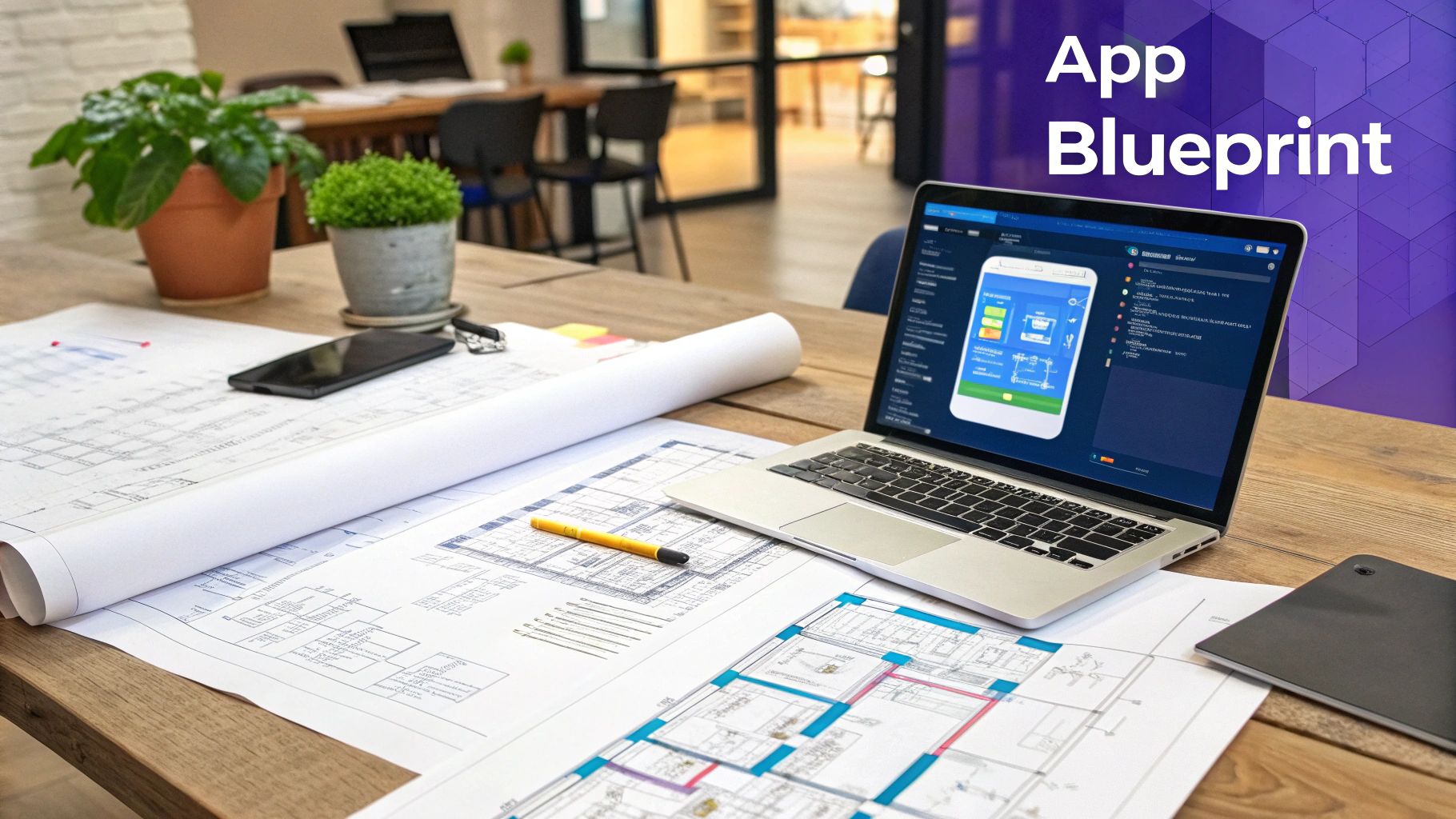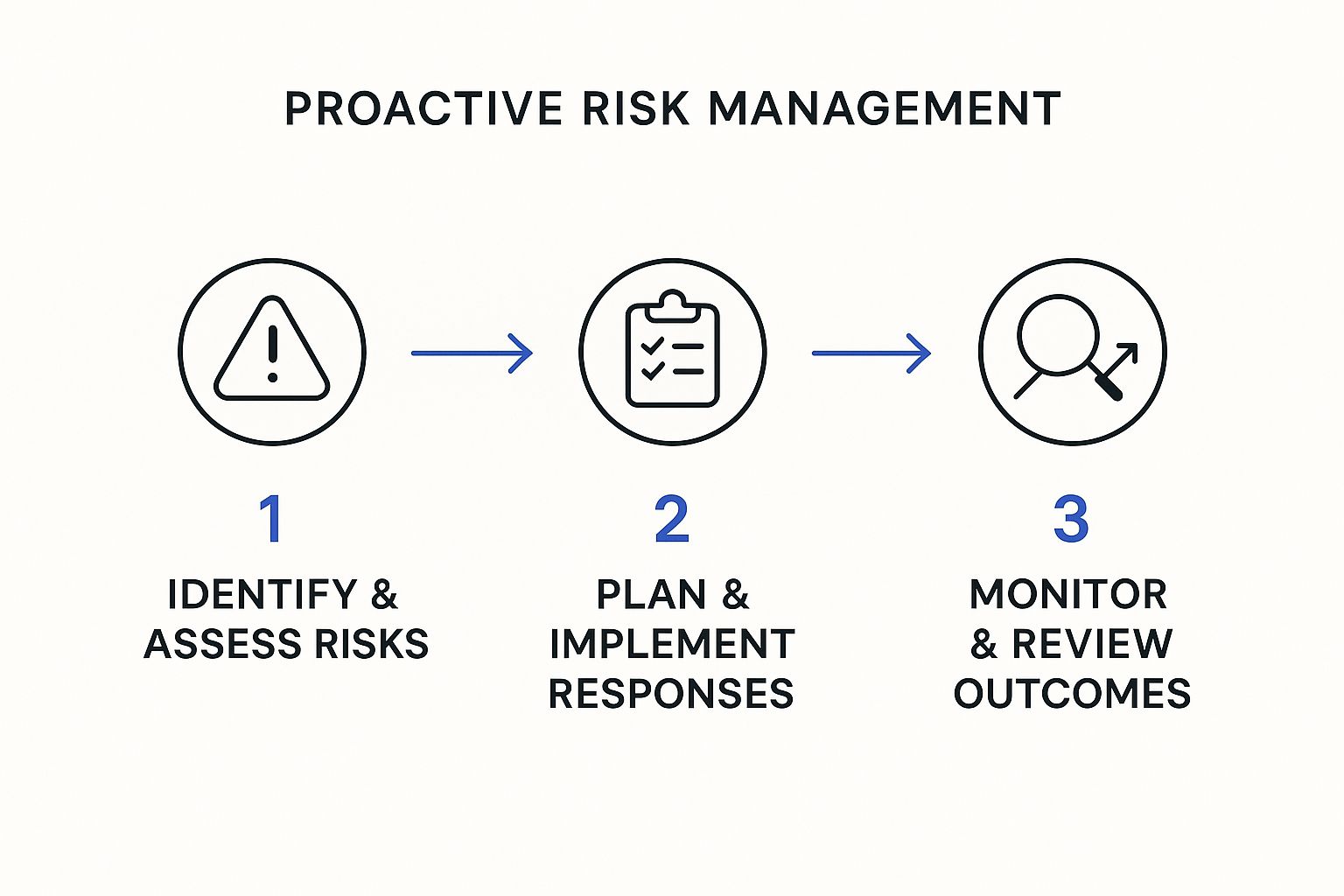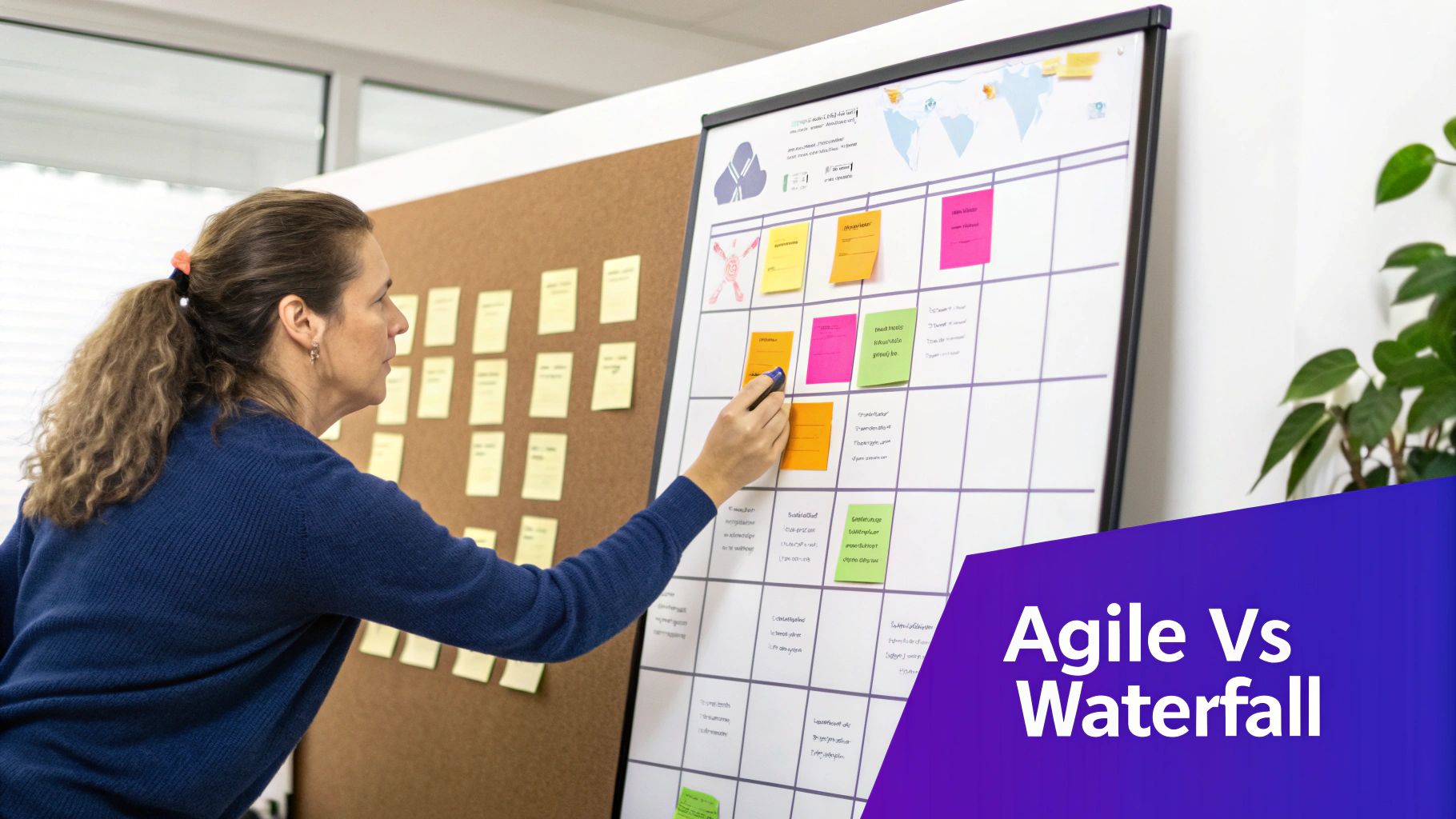Master Project Management Fundamentals for App Success
Master Project Management Fundamentals for App Success
Project management is the engine room of any successful project. It's the set of core principles—like scope, time, cost, and risk—that gives you a solid structure to deliver on time and, crucially, within budget. Think of it as the master blueprint for any complex job, especially in a high-stakes field like app development.
Your Blueprint for Building Successful Apps

Putting together a world-class mobile app is a lot like building a skyscraper. You wouldn't dream of starting without a master architect and a detailed blueprint. Throwing the best materials and builders at a project without a plan will only get you a shaky, unreliable mess. In our world, that blueprint is project management.
These core principles aren’t just nice-to-haves; they're non-negotiable for success, particularly in the fiercely competitive UK app market.
This guide will break down these fundamentals, showing you exactly how they turn a brilliant idea into a tangible, high-performing app that users love. Getting these concepts right is the first major step in the journey, which we explore from start to finish in our complete guide to app development in the UK from concept to launch.
Why Fundamentals Matter in App Development
In the fast-moving world of mobile tech, it’s all too easy to get lost in the excitement of new features and shiny code. But the apps that truly succeed are always built on a solid foundation of organised planning. Project management is the framework that ensures every single line of code serves a real purpose and every feature aligns with your business goals.
As a specialist UK Flutter developer, this is the structure that allows us to deliver exceptional apps that run like a dream across all platforms. It’s what lets us:
- Define Clear Objectives: We know exactly what success looks like before a single line of code is ever written.
- Allocate Resources Effectively: Every developer hour and every pound of the budget is put to work for maximum impact. No waste.
- Anticipate and Mitigate Risks: We can spot potential roadblocks—from tricky technical hurdles to sudden market shifts—and have a plan ready for them.
- Ensure Consistent Quality: This process guarantees that quality isn't just a final check, but is baked into every single stage of development.
A disciplined approach to project management ensures that creativity and technical skill are channelled effectively. It stops projects from derailing due to poor planning or unforeseen challenges.
The Real-World Impact on UK Projects
You can see just how important these principles are when you look at the UK's project management landscape. Recent data shows around 85% of managers are juggling multiple projects at once, making efficiency absolutely essential.
Financial discipline is another huge challenge. A staggering 10% of every project pound is wasted due to poor performance. This really brings home how critical a firm grasp of the fundamentals is for avoiding costly mistakes and seeing a real return on your investment.
By applying these core concepts, you set your Flutter app project on the path to success right from day one.
Defining Your Project Scope to Prevent Overload

Before a single line of code is written, the most important step you can take is defining your project’s scope. Think of the scope as the blueprint for your app; it’s a clear, agreed-upon definition of what the app will do and, crucially, what it won’t do. It creates the boundaries that protect your project from its biggest threat.
That threat is scope creep, the silent killer of timelines and budgets. It’s what happens when new features and ideas get added piece by piece after the project has already started, slowly bloating the original plan until it's unrecognisable. Don't underestimate it – studies show that over 52% of projects suffer from scope creep, making a rock-solid initial definition absolutely vital.
Crafting a Clear Scope Statement
Your first line of defence is the Scope Statement. This isn't just a quick list of features; it's a detailed document that lays out the project's objectives, deliverables, constraints, and assumptions. It acts as the formal agreement between your team and stakeholders, getting everyone on the same page from day one.
Let’s say we’re building a new e-commerce app for a UK clothing boutique using Flutter. A weak scope would be something vague like, "Build an online shopping app." A strong Scope Statement gets right into the specifics:
- Objective: To launch a high-performance Flutter app for iOS and Android that allows UK customers to browse, purchase, and review products.
- Key Deliverables: A secure user login system, a product catalogue with filters, a shopping basket, and an integrated payment gateway.
- Exclusions (What it won't do): The first version will not include international shipping, a loyalty points system, or AI-powered style recommendations.
This level of clarity leaves no room for misunderstanding and gives the development team a precise target. The focus stays locked on the core functionality, which is the same principle behind a Minimum Viable Product. To see this in action, check out these brilliant MVP examples from successful companies.
A well-defined scope is the bedrock of good project management. It provides a clear framework for making decisions, managing what stakeholders expect, and measuring success as you move through development.
Breaking Down the Vision with a WBS
Once your Scope Statement defines what you're building, the Work Breakdown Structure (WBS) explains how you'll build it. The WBS is a fantastic tool that deconstructs the entire project into smaller, much more manageable chunks of work. It takes the big-picture goals from the scope and breaks them down into individual tasks.
Using our Flutter e-commerce app example, the "secure user login system" deliverable might be broken down in the WBS like this:
- User Authentication Module
- Design UI for Login & Sign-up Screens
- Develop Front-End for Input Fields
- Set Up Backend Database for User Data
- Implement Password Encryption Logic
- Integrate Social Media Login (e.g., Google)
- Conduct Security & Penetration Testing
This simple hierarchy transforms a big idea into a practical checklist. Each small task can now be assigned to a team member, estimated for time and cost, and tracked with real accuracy. This is how you build realistic timelines and budgets, ensuring the project stays on course and delivers exactly what was promised.
Balancing Time, Cost, and Quality
Every app development project lives and breathes by the classic project management triangle. It’s a simple but powerful idea: you have three core constraints – time, cost, and quality. Picture a triangle where each side represents one of these elements. If you decide to shorten one side, say, by cutting the project timeline, the other two sides have to adjust. You might need to increase the budget (cost) to add more developers, or you might have to scale back on a few features (quality) to make the deadline.
The real goal isn't to sacrifice one for the other. It's about finding that sweet spot, the perfect balance that lines up with what your business needs to achieve. Nailing this equilibrium is what separates a chaotic project from a successful one. It’s all about making smart, strategic choices upfront instead of being forced into last-minute compromises down the line.
Mastering Your Project Timeline
In the fast-moving world of app development, time is your most precious resource. A delayed launch isn’t just an inconvenience; it can mean missing a golden market window or letting a competitor get the jump on you. That’s why a realistic timeline is more than just a deadline – it's your roadmap to a predictable and successful launch.
A brilliant technique for mapping this out is the Critical Path Method (CPM). It sounds technical, but the concept is straightforward. You lay out every single task needed to build the app, then identify the longest chain of dependent tasks. This chain is your "critical path" because it determines the absolute minimum time your project will take. None of the tasks on this path has any wiggle room; a delay in one of them directly pushes back your launch date.
Once you’ve identified this path, you can:
- Focus your team on the tasks that matter most to your timeline.
- Forecast your completion date with much greater accuracy.
- Make smarter calls on where to throw in extra help if things start slipping.
Developing a Realistic App Budget
If time is the road, then cost is the fuel that gets you to your destination. A solid budget does more than just cover developer salaries. It needs to account for everything required to take your app from a sketch on a napkin to a fully-fledged product in the app store, and beyond. Skimp on this, and you risk running out of cash halfway through, forcing you to slash features or cut corners on quality.
A proper budget should break down all your potential expenses:
- Development Hours: This is the big one, covering the time and expertise of your Flutter development team.
- Third-Party Services: Think about costs for APIs, cloud hosting (like AWS or Firebase), and any other services you need to integrate.
- Design and UX: Don't underestimate the investment needed to create an app that looks great and is a joy to use.
- Marketing and Launch: You need to set aside funds to actually tell people about your app and get those first crucial downloads.
Getting this right is a highly valued skill. In fact, the average salary for UK project managers recently jumped by 10% to £52,500, with top earners in demanding sectors making even more. It’s a clear sign of how much businesses value people who can manage budgets and timelines effectively. You can dig into more of these trends in the APM's latest survey on project manager earnings in the UK.
The triple constraint isn't a limitation; it's a strategic framework. Understanding how time, cost, and quality pull on each other gives you the power to make proactive decisions that keep your project on track and true to its goals.
Embedding Quality Throughout Development
Too many people think of quality as something you check for at the end – a frantic bug-squashing phase right before launch. But that’s a recipe for disaster. Real quality assurance (QA) isn't a final step; it’s a mindset that should be baked into the entire development process from day one. For a slick Flutter app, this means going way beyond just fixing crashes.
It’s about making sure your app is secure, runs smoothly even when lots of people are using it, and delivers an experience that makes users happy. Instead of saving all the testing for the end, modern agile teams integrate QA right from the start. Developers write tests for their own code, QA specialists test features the moment they’re built, and real user feedback is brought in as early as possible.
This approach stops tiny issues from becoming massive, expensive problems later on. It’s the difference between launching a rock-solid app that people love and releasing something that frustrates users and gets torn apart in the reviews. By keeping these three constraints—time, cost, and quality—in balance, you’re not just managing a project; you’re building a foundation for success.
Navigating Uncertainty with Proactive Risk Management
Let's be honest: every single app project hits a few bumps in the road. Even the most perfectly planned ones. The secret to success isn’t about trying to dodge every single problem—that’s just not realistic. It’s about seeing them coming and having a plan ready. This is the heart of proactive risk management, a skill that separates the pros from the amateurs. It’s about shifting your team from constantly putting out fires to preventing them from starting in the first place.
Instead of getting blindsided by a crisis, this process is all about looking ahead and spotting potential threats before they ever become real problems. This foresight gives you the control you need to navigate uncertainty, safeguarding your timeline, your budget, and the quality of your finished app. For something as complex as app development, this isn't just a nice-to-have; it's absolutely essential.
Identifying and Assessing Potential Risks
First things first: you need to get everything that could go wrong out on the table. This isn’t a doom-and-gloom session. It’s about being pragmatic and prepared. When you're building a Flutter app, most risks tend to fall into a few common categories, which gives you a great starting point for your brainstorming.
Grab your team and start thinking through the potential pitfalls from every angle:
- Technical Risks: What’s the plan if a critical third-party API suddenly gets deprecated or changes its terms? What if the next Flutter SDK update introduces a breaking change that messes with our codebase?
- Resource Risks: What happens if our lead developer unexpectedly hands in their notice mid-sprint? Is there a danger of budget cuts suddenly shrinking our team?
- External Risks: How would we handle it if Apple or Google suddenly changed their app store policies right before our launch? What if a competitor drops a similar feature just before we do?
Once you’ve got a list, the next step is to weigh them up. You need to estimate two things for each potential issue: its likelihood (how likely is this to actually happen?) and its impact (if it does happen, how bad will it be?). A simple bit of analysis like this helps you cut through the noise and focus on what truly matters.
This visual captures the simple, cyclical flow of spotting risks, planning how to respond, and keeping an eye on things.

As the infographic shows, managing risk isn't a one-and-done task. It’s a continuous cycle of being vigilant and ready to adapt.
Creating Your Risk Response Plan
After you've identified and prioritised your risks, it’s time to decide what you’re going to do about them. This is where you create a risk register—a straightforward document that becomes your playbook for dealing with whatever comes your way. For every major risk, you’ll outline a clear, actionable response strategy.
A risk register transforms abstract worries into a concrete action plan. It ensures that when a problem does arise, your team isn't scrambling for a solution—they're executing a pre-agreed strategy.
Your response will typically fall into one of four buckets. Let's use our example of a key Flutter developer potentially leaving the project to see how this plays out in the real world.
| Response Strategy | Description | Example Action |
|---|---|---|
| Avoid | Eliminate the threat entirely by changing your project plan. | This is often not possible for resource risks. |
| Mitigate | Reduce the probability or impact of the risk. | Action: Document all key processes and ensure knowledge is shared across the team, not held by one person. |
| Transfer | Shift the impact of the risk to a third party. | Action: Engage a trusted UK-based Flutter agency for support, providing a backup resource if needed. |
| Accept | Acknowledge the risk and do nothing, usually for low-impact issues. | Action: Accept the risk but have a contingency plan ready, such as a pre-approved budget for fast-tracked hiring. |
Going through this process ensures that for your highest-priority risks—the ones with high likelihood and high impact—you have a solid mitigation or transfer strategy ready to deploy. You’re not just crossing your fingers and hoping for the best; you're actively planning for the worst. This disciplined approach is what keeps complex app projects on track, even when the unexpected inevitably happens.
Choosing the Right Framework for App Development

Once you've got a handle on the project management fundamentals, it's time to pick the methodology that will actually guide your build. Think of it this way: if scope, time, cost, quality, and risk are your ingredients, the framework is the recipe that brings them all together.
When it comes to modern app development, this choice usually boils down to two very different philosophies: Waterfall and Agile. Each one offers a unique roadmap for turning a brilliant idea into a polished app in your users' hands.
The Old School Approach: Waterfall
The Waterfall methodology is the classic, linear way of managing projects. It’s a highly structured process where you have to complete one stage in its entirety before you can even think about starting the next—just like water flowing down a series of cascades. You’d define every single requirement, finish the design, then build the whole thing, and finally, test it at the very end.
This rigid approach can work for projects where the goal is crystal clear and won't change, like building a bridge. But in the fast-paced world of mobile apps, where user feedback and market trends can shift overnight, this inflexibility is a massive drawback. You could easily spend a year building what you thought users wanted, only to launch and find out their needs have completely changed.
The Modern, Flexible Path: Agile
In stark contrast, Agile methodologies are built to embrace change. Instead of one long, rigid process, Agile breaks the project down into small, manageable cycles known as sprints.
Each sprint, which typically lasts two to four weeks, focuses on delivering a small, working piece of the app. At the end of every cycle, the team gets together, reviews the progress, gathers feedback, and fine-tunes the plan for the next sprint.
This iterative process is a perfect match for building high-performance Flutter applications. It allows for constant improvement and ensures the final product is truly centred around the user. If a feature isn’t landing well with testers or a better idea comes along mid-project, the team can pivot quickly without derailing everything.
Agile isn't just a process; it's a mindset focused on collaboration, flexibility, and delivering value early and often. It transforms project management from a rigid plan into a responsive, learning-oriented journey.
For building powerful apps, Agile is the clear winner. While other frameworks have their place, the performance advantages of Flutter really come to life in an Agile environment. If you want to dive deeper into the technical side, you can explore our detailed comparison of Flutter vs React Native and see which is best for your app, where new benchmarks consistently put Flutter at the top for performance.
Why Agile Excels for Flutter Development
Adopting an Agile framework like Scrum or Kanban brings some serious advantages to any Flutter project. Its core principles are perfectly in sync with the goals of modern app development.
- Faster Time to Market: By getting a functional Minimum Viable Product (MVP) out the door early, you can start gathering valuable real-world data from actual users much sooner.
- Superior Product Quality: Continuous testing and feedback loops are baked right into the process. Bugs are caught and squashed within each sprint, not left to pile up for a frantic pre-launch crunch.
- Increased Stakeholder Engagement: Regular demos and reviews keep clients and stakeholders in the loop, ensuring the app being built is the app they envisioned.
- Enhanced Team Morale: When teams are empowered and self-organising, they take greater ownership of their work. This leads directly to higher motivation and more creative problem-solving.
Ultimately, whether you follow a strict Waterfall plan or a nimble Agile approach, those core project management fundamentals are your constant guide. They provide the universal structure you need to ensure that no matter which recipe you follow, you’re still creating a high-quality, successful product.
Frequently Asked Questions
When you’re first getting your head around app development, it’s natural for questions to pop up, especially when applying project management fundamentals for the first time. We get asked a lot of the same things, so we’ve gathered the most common queries right here to give you clear, straightforward answers.
Think of this as your quick-reference guide for those specific scenarios you’ll almost certainly run into on your development journey.
What Is the Most Important Fundamental for a Startup App Project?
For any startup staring down the barrel of a tight budget and an even tighter timeline, Scope Management is, without a doubt, the most critical piece of the puzzle. With limited cash and time, clearly defining what your app will and, just as importantly, will not do is your best line of defence against scope creep. It’s the silent killer that can drain your funds and push your launch date into the distant future.
This is where a razor-sharp Minimum Viable Product (MVP) scope becomes your superpower. It forces the entire team to focus on delivering the absolute core value to your first users. That focus allows you to get crucial feedback and iterate quickly without burning through resources on nice-to-have features that nobody asked for.
How Does Agile Incorporate Traditional Fundamentals Like Budget?
A common misconception is that Agile methodologies just throw the budget out of the window. The reality is they just look at the problem from a different angle. Instead of starting with a fixed scope and figuring out the budget, Agile often flips the script. A project gets a fixed budget and a fixed timeline—say, six months' worth of two-week development cycles (or sprints).
Within that fixed container of time and money, the team’s job is to prioritise and deliver the most valuable features first. This approach guarantees that you have a functional, valuable, and shippable product within your budget, even if not every single idea from the initial brainstorming session makes it into version one. It's all about delivering maximum value within known constraints.
What Are the Best Project Management Tools for a Flutter Team?
For a Flutter team working in an Agile way, there’s no single "best" tool—it’s usually a combination that hits the sweet spot.
Powerful platforms like Jira are fantastic for managing complex sprints, meticulously tracking technical issues, and pulling together detailed reports. On the other hand, for teams who thrive on a more visual and intuitive workflow, tools like Trello or Asana offer clean, user-friendly Kanban boards that make it incredibly easy to see the status of every task at a glance.
At the end of the day, the best tools are the ones your team genuinely buys into and uses consistently. Whichever you choose, integrating it with a seamless communication tool like Slack or Microsoft Teams is absolutely non-negotiable for keeping everyone on the same page.
Ready to build a high-performance app with a team that has truly mastered these fundamentals? At App Developer UK, we specialise in creating stunning Flutter applications that deliver real-world results. Contact us today to talk about your vision.